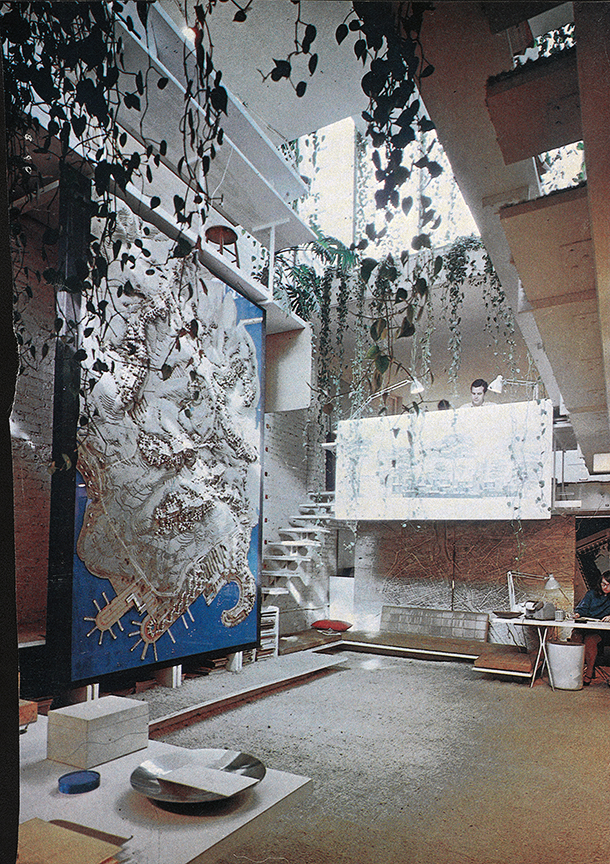Welcome to the Archives of The Paul Rudolph Institute for Modern Architecture. The purpose of this online collection is to function as a tool for scholars, students, architects, preservationists, journalists and other interested parties. The archive consists of photographs, slides, articles and publications from Rudolph’s lifetime; physical drawings and models; personal photos and memorabilia; and contemporary photographs and articles.
Some of the materials are in the public domain, some are offered under Creative Commons, and some are owned by others, including the Paul Rudolph Estate. Please speak with a representative of The Paul Rudolph Institute for Modern Architecture before using any drawings or photos in the Archives. In all cases, the researcher shall determine how to appropriately publish or otherwise distribute the materials found in this collection, while maintaining appropriate protection of the applicable intellectual property rights.
In his will, Paul Rudolph gave his Architectural Archives (including drawings, plans, renderings, blueprints, models and other materials prepared in connection with his professional practice of architecture) to the Library of Congress Trust Fund following his death in 1997. A Stipulation of Settlement, signed on June 6, 2001 between the Paul Rudolph Estate and the Library of Congress Trust Fund, resulted in the transfer of those items to the Library of Congress among the Architectural Archives, that the Library of Congress determined suitable for its collections. The intellectual property rights of items transferred to the Library of Congress are in the public domain. The usage of the Paul M. Rudolph Archive at the Library of Congress and any intellectual property rights are governed by the Library of Congress Rights and Permissions.
However, the Library of Congress has not received the entirety of the Paul Rudolph architectural works, and therefore ownership and intellectual property rights of any materials that were not selected by the Library of Congress may not be in the public domain and may belong to the Paul Rudolph Estate.
LOCATION
Address: 26 West 58th Street
City: New York
State: New York
Zip Code: 10019
Nation: United States
STATUS
Type: Office
Status: Demolished
TECHNICAL DATA
Date(s): 1964
Site Area:
Floor Area:
Height:
Floors (Above Ground):
Building Cost:
PROFESSIONAL TEAM
Client: Paul Rudolph
Architect: Paul Rudolph
Associate Architect:
Landscape:
Structural:
MEP:
QS/PM:
SUPPLIERS
Contractor:
Subcontractor(s):
Paul Rudolph Architectural Office
In 1965 Rudolph rents the top floor of a six-story building at 26 West 58th Street.
Rudolph discovers that, by raising the roof over the front part of the building almost 4 feet, he can add a mezzanine floor which can be used for drafting space.
Because of the low cost of the rent, Rudolph determines he can afford to do the construction, even for a short-term basis. Rudolph opens up the roof in the middle of the plan and builds a two-story glass pavilion which encloses a desk-conference area on the south side and a conference area for himself above it with his own drafting table cantilevered out over the desk-conference area below.
The floating platforms are supported on steel brackets (1-1/2” x 1”) bolted to the brick party walls or to joists. “It was only slightly shaky,” according to Rudolph.
In 1969 Rudolph relocates his office to 4 West 57th Street
In 1971 Sheldon Solow of the Solow Building Corporation demolishes the building and hires Gordon Bunshaft of Skidmore, Owings and Merrill to design a 50 story skyscraper - known as the Solow Building - which is later built on the site in 1974.
“Do you realize that 95 percent of architecture through the ages could not have been built under the existing laws. We could almost say that architecture has been outlawed.”
“From the street, you went through a 1930’s black glass, chipped anodized aluminum new front on a decent six-story loft building. The lobby was wood papered; then, up a Gropius-battleship-gray shipping elevator with asphalt tile - marbelized, of course.”
“It was usually disconcerting on first visit because suddenly, after being in the elevator, the space was not defined. And when people know the definite limitations of a space they are more happy. This space was free flowing vertically, like a Mies plan turned on edge.”
“The sun was arranged. I mean, the windows were arranged so that a beam of light penetrated deep into the lowest level of the tall, central space. Yet, there was no glare.”
DRAWINGS - Design Drawings / Renderings
DRAWINGS - Construction Drawings
DRAWINGS - Shop Drawings
PHOTOS - Project Model
PHOTOS - During Construction
PHOTOS - Completed Project
PHOTOS - Current Conditions
LINKS FOR MORE INFORMATION
RELATED DOWNLOADS
PROJECT BIBLIOGRAPHY
“Chronological list of works by Paul Rudolph, 1946-1974.” il. Architecture and Urbanism 49 (January 1975): 161.
“Paul Rudolph Office.” il., sec. Architecture and Urbanism 80 (July 1977): 178-179.
Rudolph, Paul. Paul Rudolph Dessins D’Architecture. Fribourg: Office du Livre, 1974. il., sec. pp. 140-141.
“Rudolph’s dare-devil office destroyed.'“ il., plan, sec., port. Progressive Architecture 50 (April 1969): 98-105.
Smith, C. Ray. Supermannerism: New Attitudes in Post-Modern Architecture. New York: Dutton, 1977. il., sec. pp. 147-149.



































